That massive head must be important for something.
The better to eat you with...
And oh, I am in awe... those are great looking.
Posted 27 March 2016 - 09:55 PM
That massive head must be important for something.
The better to eat you with...
And oh, I am in awe... those are great looking.
Posted 27 March 2016 - 10:45 PM
I am thinking the head allows sucking in eats easier from all direction around head.
Posted 28 March 2016 - 01:54 PM
So are they ingesting brine shrimp via the gills too? Wow, a fish with three mouths.
Gerald Pottern
-----------------------
Hangin' on the Neuse
"Taxonomy is the diaper used to organize the mess of evolution into discrete packages" - M.Sandel
Posted 28 March 2016 - 02:27 PM
I think ingested brine shrimp still coming in via mouth. The large displacement I think makes so items do not have to be directly in front of them so can be ingested even when off to side, above or below mouth. They also have the ability to rapidly back up for a food item in part by pushing back with simultaneous movement of pectoral fins.
Posted 29 March 2016 - 04:42 PM
Edited by Michael Wolfe, 29 March 2016 - 07:18 PM.
edited to insert the video
Posted 30 March 2016 - 09:27 AM
Posted 02 April 2016 - 09:18 AM
Pirate Perch fry are now pushing an inch inn total length and well within size range I catch in the field. Between 70 and 80 remain from the original 120. Most mortalities thus far appear related to water quality issues that occured when water exchange was low (36-h residence time). Increase flow pushed temperatures down to about 57 F that has been consistently maintained for about last 2 weeks. Growth rates may have accelerated with that change. I am contemplating the training fry to eat a pelleted formulation. Current feeding regimen has not resulted in fry coming to me when applying BS. Thus far they have been fed in excess. The Pirate Perch's method prey detection has not promoted what I feel will get fish to concentrate in areas were feed will be introduced during the feed training phase. I will see about introducing BS with inflow to see if they concentrate around that area.
Posted 02 April 2016 - 10:20 AM
Pirates on pellets? Has anybody else been able to pellet-train them? And on that subject, is there any good literature on the behavioral chemistry and/or tactile perception that makes a fish decide to swallow or spit out food, and learn to accept new foods? Some appear to learn from living with other fish that eat pellet/flake foods, while others just wont do it, even after years of living with pellet-feeding tankmates.
Gerald Pottern
-----------------------
Hangin' on the Neuse
"Taxonomy is the diaper used to organize the mess of evolution into discrete packages" - M.Sandel
Posted 02 April 2016 - 04:41 PM
I have had them strike at non-living items. Literature out there I have seen has concentrated of free-amino acids and lipids. Taste is certainly a factor which I can manipulate even when starting with live feeds. I may take a high quality pellet formulated for ornamental fish and give it an arthropod flavor. In past that involved a slurry of BS mixed with pellets and put directly in front of fish looking specifically for BS in a particular location. This round I will also try using drone brood as a flavoring as they will be loaded with fat in addition to the protein. My smaller group of age-1 pirate perch do go into corner where BS concentrate as a function of being positively phototaxic. That will likely be starting point with these fry. They will be trained to go into tight location after a concentrated prey source, then I will sleep them "mickey's". I think the pirate perch can do it and once on will go after pellets in a big way.
Posted 02 April 2016 - 09:35 PM
Fry even more concentrated near bottom. I think reason is BS are so cold upon introduction they immediately sink to bottom where they concentrate. That results in a nearly 2-dimensional distribution of eats for fry.
Posted 03 April 2016 - 10:00 PM
Inlet water was shut off most of the day causing temperature to rise. Fry had all cleaned up all BS. When I added more they acted as if they were on some sort of stimulant as probably enabled by the warmer temperature.
Posted 11 April 2016 - 12:07 PM
Attempting to enumerate what will be called fingerlings even though not greater than 2" long. They have tendency to pile up when startled. A few smaller fish have pinched guts and not likely to survive.
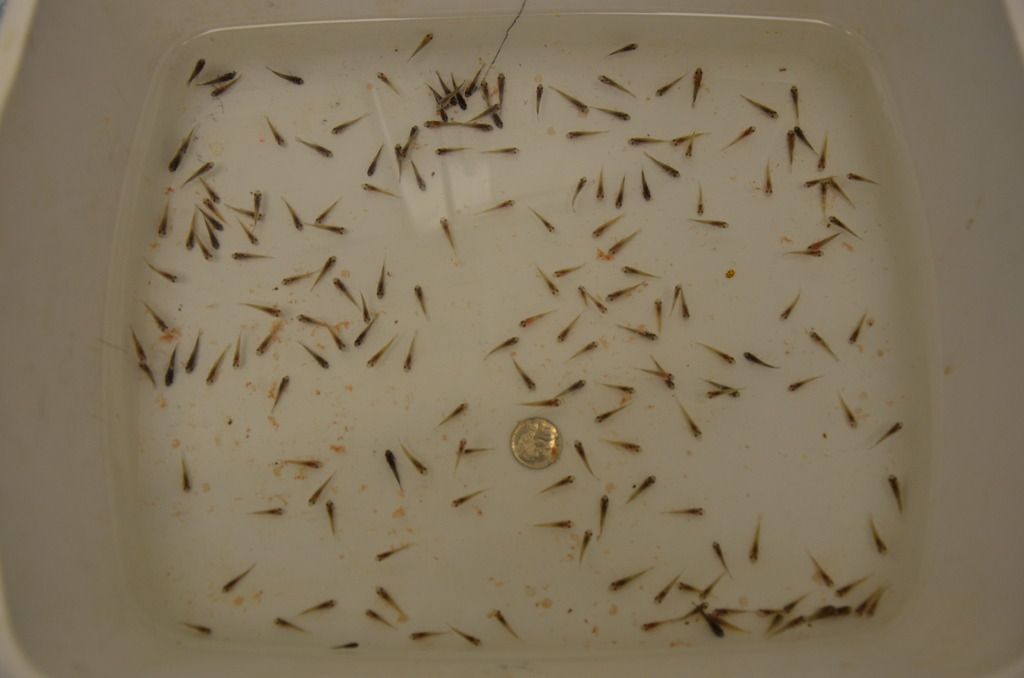

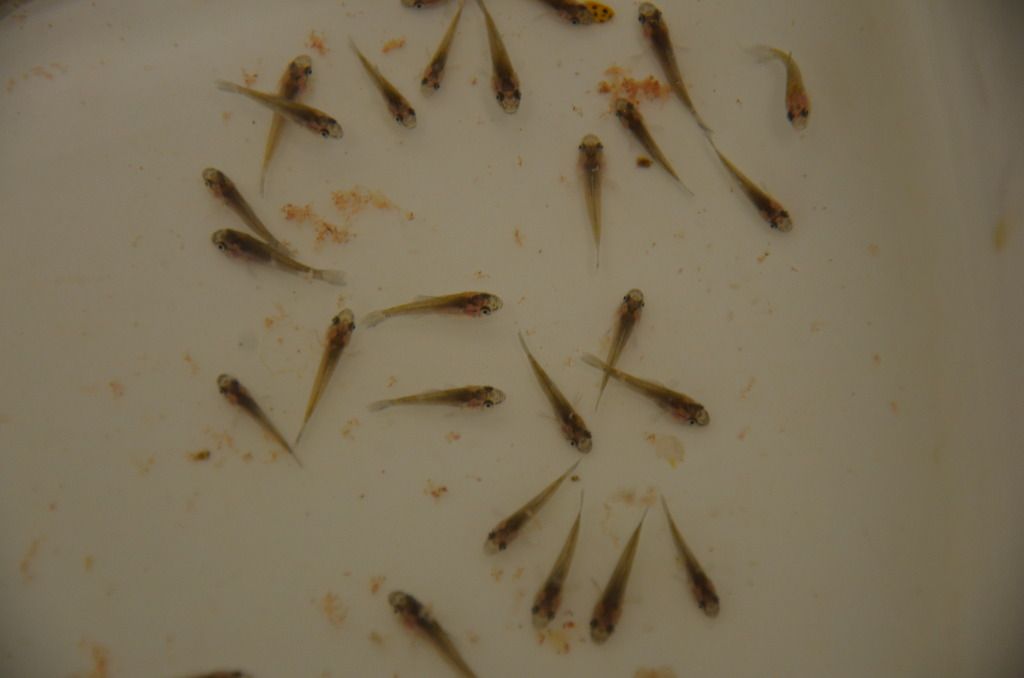
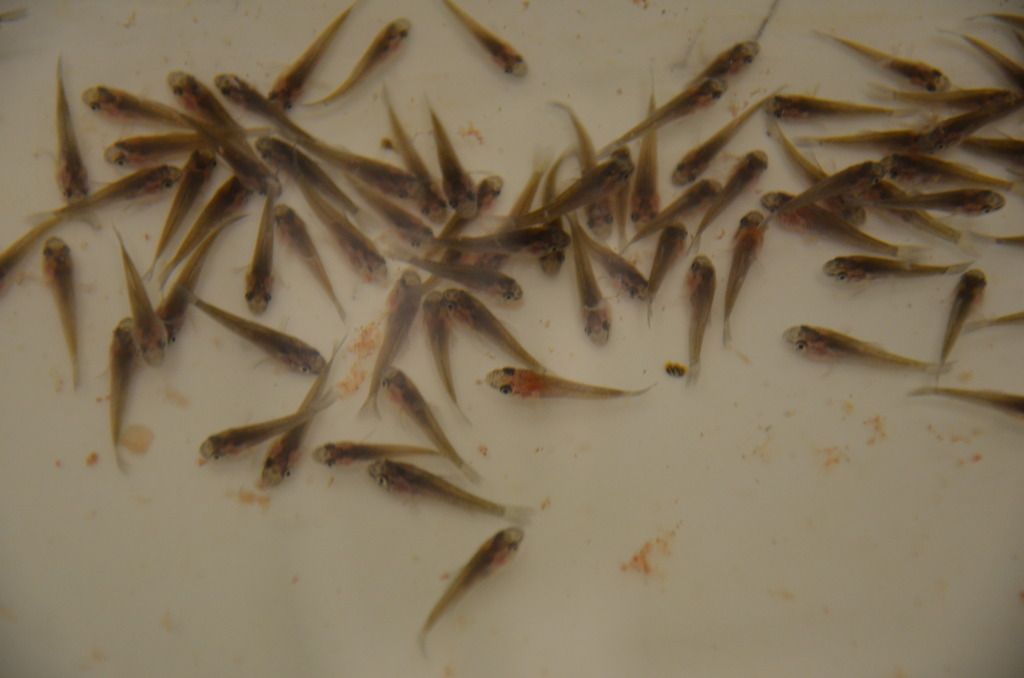
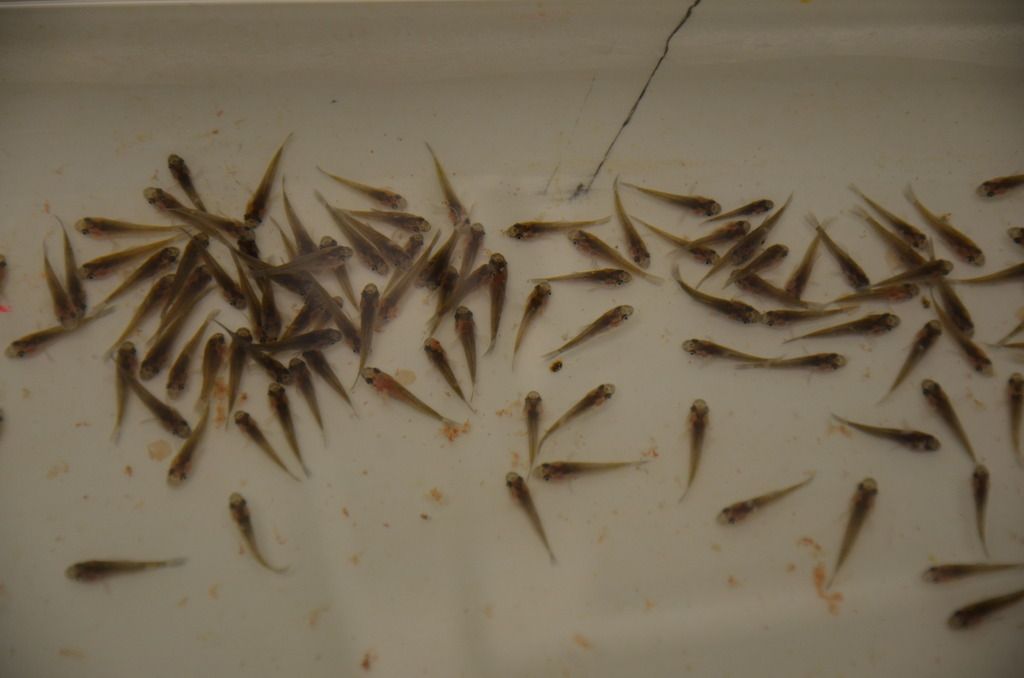
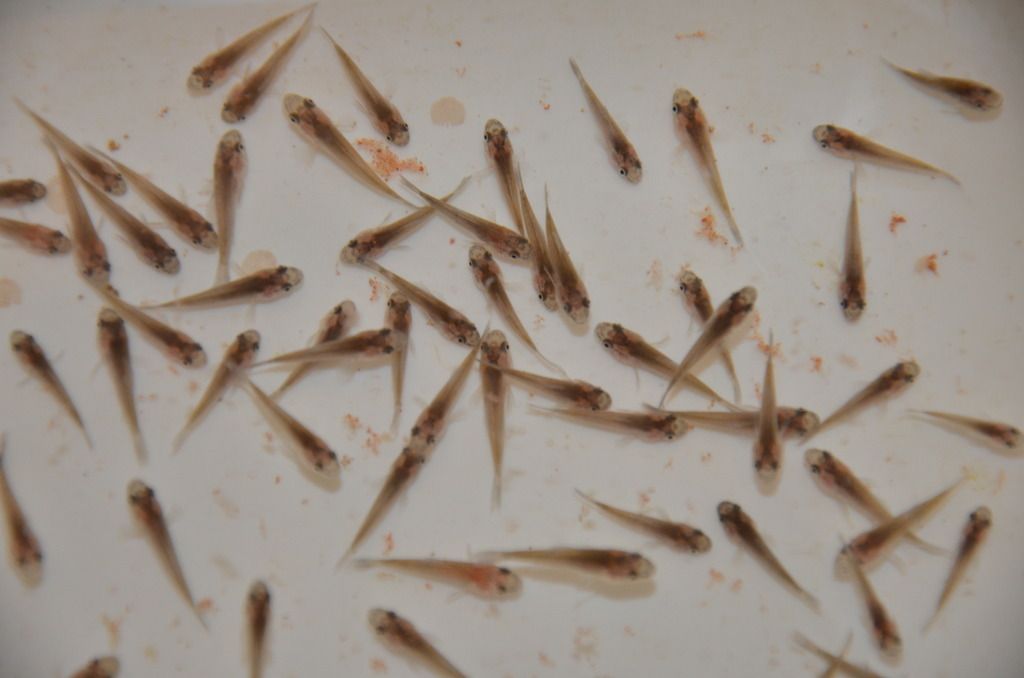

Modest modifications to this approach I think would work for rearing Spring Cave Fish and Swamp Fish in mass. It would require minimal space or effort to rear several thousand fingerlings.
Posted 11 April 2016 - 12:07 PM
Still about 120 fish. Estimate at hatch was too low. Most I have ever seen in one location.
Posted 11 April 2016 - 12:32 PM
Pirates on pellets? Has anybody else been able to pellet-train them? And on that subject, is there any good literature on the behavioral chemistry and/or tactile perception that makes a fish decide to swallow or spit out food, and learn to accept new foods? Some appear to learn from living with other fish that eat pellet/flake foods, while others just wont do it, even after years of living with pellet-feeding tankmates.
Gerald, A few years ago I had a group of five pirate perch that took dried foods. It was a big pain in the rear, but they took them. If I remember correctly, the feed I used was Hikari soft floating carnivore sticks. They were about 2cm long and spongy. The smaller fish took to frozen bloodworms, but the larger two did not. I ended up soaking the sticks in bloodworm "juice" and threw one at a time in the tank. Because they float, I had to tap the sticks with my fingers (or pencil) to make them "alive". The larger pirate perch would emerge from the plants and strike. If I did not make the food sticks move, the fish larger fish wouldn't eat. It was a tedious feeding process, but then again who doesn't like having a fat pirate perch suck in a food right at their fingertips?
Willie P
Posted 11 April 2016 - 01:03 PM
I floating cichlid feed will be used here as well although some method other than hand poking will be used to move pellets. Aeration, water flow or fan likely to be employed.
Posted 14 April 2016 - 04:55 PM
Another abrupt behavior change. Fingerlings now flighty when I walk by. Some have even jumped out. Fish also oriented in parallel relative to current promoted by supplemental aeration. Tub water level reduced to reduce odds of jumping. Fish all have massively distended bellies.
Posted 17 April 2016 - 08:01 AM
To this point I am concluding Pirate Perch are actually cool water fish like Rainbow Trout that simply can tolerate warmer temperatures like sunfish can. I did a quick comparison to Northern Bluegill growing at or near their genetic maximum of same age when reared at about 26 C. The Pirate Perch are larger in terms of length and weight even though they have been reared at about 16 C. I doubt the Pirate Perch could grow faster at the elevated temperature. The Pirate Perch need to slow down soon otherwise they will be 6" by fall.
Posted 18 April 2016 - 12:30 PM
My advisor at NCSU in the 80's Mel Huish used to joke about "Gonna cook me up a mess o' ass-in-chin brim".
You just might get them up to suitable size for that!
Gerald Pottern
-----------------------
Hangin' on the Neuse
"Taxonomy is the diaper used to organize the mess of evolution into discrete packages" - M.Sandel
Posted 18 April 2016 - 01:36 PM
I can get them to 6" but not in a timely manner.
Posted 05 February 2017 - 06:51 AM
This year, as part of a class project, we are going to scale up effort to produce indoors more then a thousand 1" Pirate Perch using 20 adults (10 males: 10 females). The rearing part will involve replicating the tubs where about six will be setup. The qualitative change will involve setting up a larger tank supporting breeding the colony where eggs will fall down beyond reach of adults yet be easy to see. This going to be fun because entire class has minimal fish culture experience. Preparing permit application and ACUC form now so we can report findings to a hatchery oriented bunch later. Would like to do some science with fry rearing, possibly trying to get them on a feed.
0 members, 0 guests, 0 anonymous users